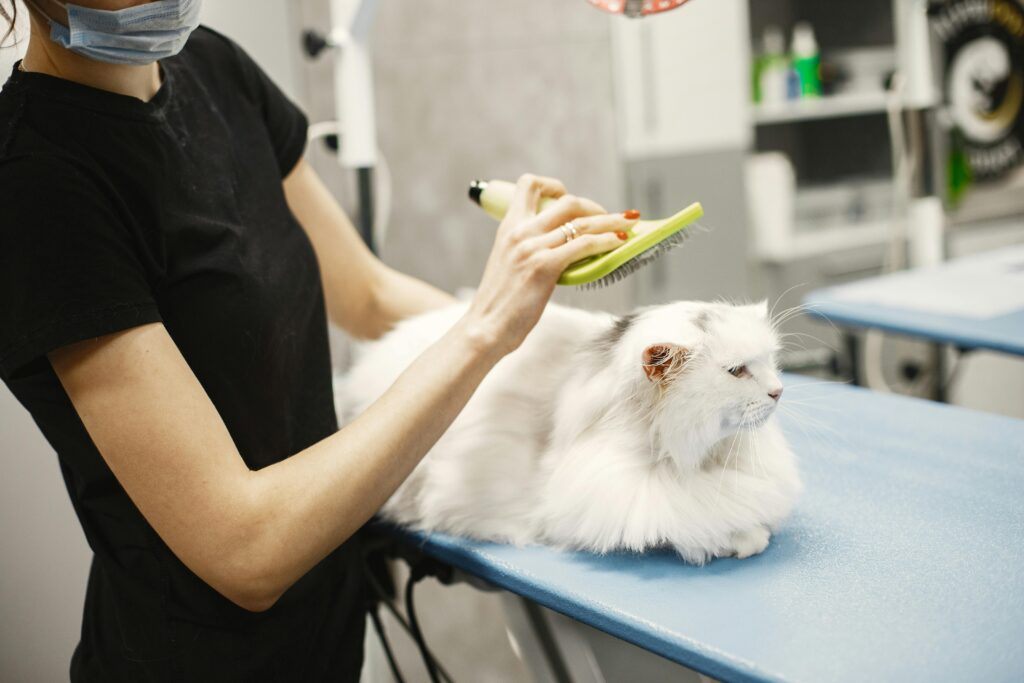Our feline companions bring endless joy and cuddles into our lives. But just like us, they’re susceptible to unwanted guests – pesky parasites like fleas and ticks. These tiny bloodsuckers can not only cause discomfort and itching for your cat but also transmit diseases. Here, we delve into the world of flea and tick prevention for cats, equipping you with the knowledge and tools to keep your precious kitty safe and healthy.
The Uninvited Guests: Fleas and Ticks
Fleas: These tiny, wingless insects are jumping champions, easily hopping onto your cat from other animals, infested environments, or even through open windows. They feed on your cat’s blood, causing intense itching and irritation.
Symptoms of Flea Infestation:
- Excessive scratching and biting, particularly around the tail base
- Visible fleas or flea dirt (tiny black specks that resemble pepper) on your cat’s fur or bedding
- Hair loss, especially due to scratching
- Red, inflamed skin
Ticks: These eight-legged arachnids attach themselves to your cat and feed on its blood for days or even weeks. Ticks can transmit various diseases, some of which can be serious.
Symptoms of Tick Infestation:
- Visible ticks attached to your cat’s fur, often found around the head, neck, and ears
- Redness or swelling around the tick bite site
- Listlessness or fatigue
The Importance of Parasite Prevention
Preventing flea and tick infestations is crucial for your cat’s health and well-being. Here’s why:
- Reduced Discomfort and Itching: By keeping fleas and ticks at bay, you prevent the constant irritation and scratching that can cause significant discomfort and even lead to skin infections.
- Disease Prevention: Fleas and ticks can transmit serious diseases to cats, such as tapeworm infections, Lyme disease, and ehrlichiosis.
- Peace of Mind for You: Knowing your cat is protected from these parasites allows you and your feline friend to relax and enjoy quality time together.
Choosing the Right Prevention Method
The ideal flea and tick prevention method for your cat depends on several factors, including:
- Lifestyle: Indoor/outdoor cats, cats who frequent boarding facilities, or those with travel plans may require different approaches.
- Age: Kittens and senior cats may need specific products formulated for their age group.
- Health: Cats with allergies or other health conditions might benefit from particular types of preventatives.
Here’s an overview of common flea and tick prevention options:
1. Topical Medications: These easy-to-use liquids are applied to the back of your cat’s neck and offer protection for several weeks. Popular options include Revolution®, Advantage II®, and Frontline® Gold.
2. Oral Medications: These chewable tablets offer a convenient alternative for cats who dislike topical treatments. Examples include Bravecto® and Simparica Trio™.
3. Collars: Flea and tick collars provide continuous protection but might be less effective than other methods for some cats.
4. Sprays: While not a primary preventative, sprays can be helpful for treating existing infestations or targeting specific areas.
5. Environmental Treatments: Vacuuming regularly and washing bedding in hot water can help eliminate fleas and ticks in your home environment.
Consulting Your Veterinarian
Discussing the best parasite prevention plan with your veterinarian is key. They can assess your cat’s individual needs and recommend an appropriate product.
Additional Tips for a Parasite-Free Home:
- Regular Checkups: Schedule regular checkups with your veterinarian, who can identify potential infestations early.
- Treat Your Home: If you find fleas or ticks on your cat, you’ll need to treat your entire home environment, including carpets, furniture, and pet bedding.
- New Pets: Always introduce new pets to your home environment after they’ve been treated for fleas and ticks.
- Beware of DIY Solutions: Avoid using flea and tick products meant for dogs on your cat, as they can be toxic.
Living with an Indoor Cat? Don’t Be Complacent!
Even indoor cats are susceptible to flea and tick infestations. Fleas can enter your home on your clothing or through open doors and windows, while ticks can be picked up from contact with other pets or infested environments brought indoors on shoes. Year-round parasite prevention remains important for all cats, regardless of their indoor/outdoor status.
Benefits of Consistent Prevention
Maintaining a consistent parasite prevention routine offers numerous benefits:
- Reduced Risk of Disease: By preventing flea and tick infestations, you significantly reduce the risk of your cat contracting serious diseases.
- Improved Cat’s Well-Being: A cat free from the irritation and discomfort of fleas and ticks will be happier and healthier.
-
Natural Flea and Tick Control: A Word of Caution
While some pet owners explore natural alternatives for flea and tick control, it’s crucial to approach them with caution. Many natural remedies lack the scientific backing and efficacy of veterinary-approved preventatives. Some essential oils and herbal ingredients can even be toxic to cats. Always consult your veterinarian before using any natural flea and tick control methods on your cat.
The Importance of Early Detection and Treatment
If you suspect your cat has fleas or ticks, early detection and treatment are vital. Here’s what to do:
- Perform a Thorough Check: Examine your cat’s fur for fleas, flea dirt, or ticks. Part the fur, particularly around the head, neck, tail base, and between the toes.
- Start Treatment Immediately: Once you’ve identified fleas or ticks, begin treatment using a vet-recommended product.
- Clean Your Home: Vacuum thoroughly, wash bedding in hot water, and consider using a pet-safe flea spray for your home environment.
Addressing a Full-Blown Infestation
If you find yourself battling a full-blown flea or tick infestation, it’s important to act swiftly and comprehensively. Here’s a recommended approach:
- Treat Your Cat: Administer a veterinarian-approved flea and tick preventative immediately.
- Treat Your Home: Vacuum meticulously, wash all bedding and pet items in hot water, and consider a professional pest control treatment for your home.
- Be Patient: Eliminating a full-blown infestation takes time and persistence. Continue treatment according to your veterinarian’s instructions.
FAQs: Your Questions Answered
1. How often should I treat my cat for fleas and ticks?
The frequency of treatment depends on the product used. Some topical medications offer protection for several weeks, while oral medications might last for several months. Consult your veterinarian to determine the ideal schedule for your cat.
2. My cat hates topical treatments. Are there any alternatives?
Yes, there are! Oral medications and flea and tick collars offer alternative options. Discuss these options with your veterinarian to find a solution that works best for your cat.
3. Is it safe to use a flea and tick collar with a topical treatment?
Generally, it’s not recommended to combine these methods, as it can lead to over-medication and potential side effects. Consult your veterinarian for specific advice.
4. I found a tick on my cat. What should I do?
Carefully remove the tick with a tick removal tool designed for pets. Do not squeeze or crush the tick’s body. Once removed, dispose of it properly and monitor your cat for any signs of illness. Consider consulting your veterinarian if you have trouble removing the tick or notice any concerning symptoms.
5. Can I use human flea and tick medication on my cat?
Absolutely not! Human flea and tick products are formulated for humans and can be toxic to cats. Stick to vet-approved products specifically designed for felines.
6. My cat seems lethargic after applying a topical flea treatment. Is this normal?
Mild side effects like temporary lethargy or itchiness at the application site can occur in some cases. If the symptoms are severe or persist, contact your veterinarian immediately.
7. I’m on a tight budget. Are there affordable flea and tick prevention options?
Discuss budget-friendly options with your veterinarian. Some clinics offer discounts on parasite prevention products or may carry generic versions of brand-name medications.
8. I live in a warm climate. Do I still need to worry about fleas and ticks in winter?
Unfortunately, yes. Fleas can survive indoors year-round, and ticks can still be active in warmer winter months. Maintain consistent parasite prevention throughout the year for optimal protection.
9. Can I prevent fleas and ticks from getting on my cat in the first place?
While complete prevention isn’t always possible, regular grooming, using a flea comb, and keeping your home clean can help minimize the risk.
10. What are some signs that my cat might have a flea allergy?
Excessive scratching and biting, hair loss, red, inflamed skin, and scabbing can all be signs of a flea allergy. If you suspect your cat has a flea allergy, consult your veterinarian for proper diagnosis and treatment.
Conclusion
By implementing a consistent parasite prevention plan, maintaining a clean environment, and staying vigilant about early detection, you can significantly reduce the
Less Stress for You: Knowing your cat is protected gives you peace of mind and allows you to enjoy a stress-free relationship with your furry companion.









